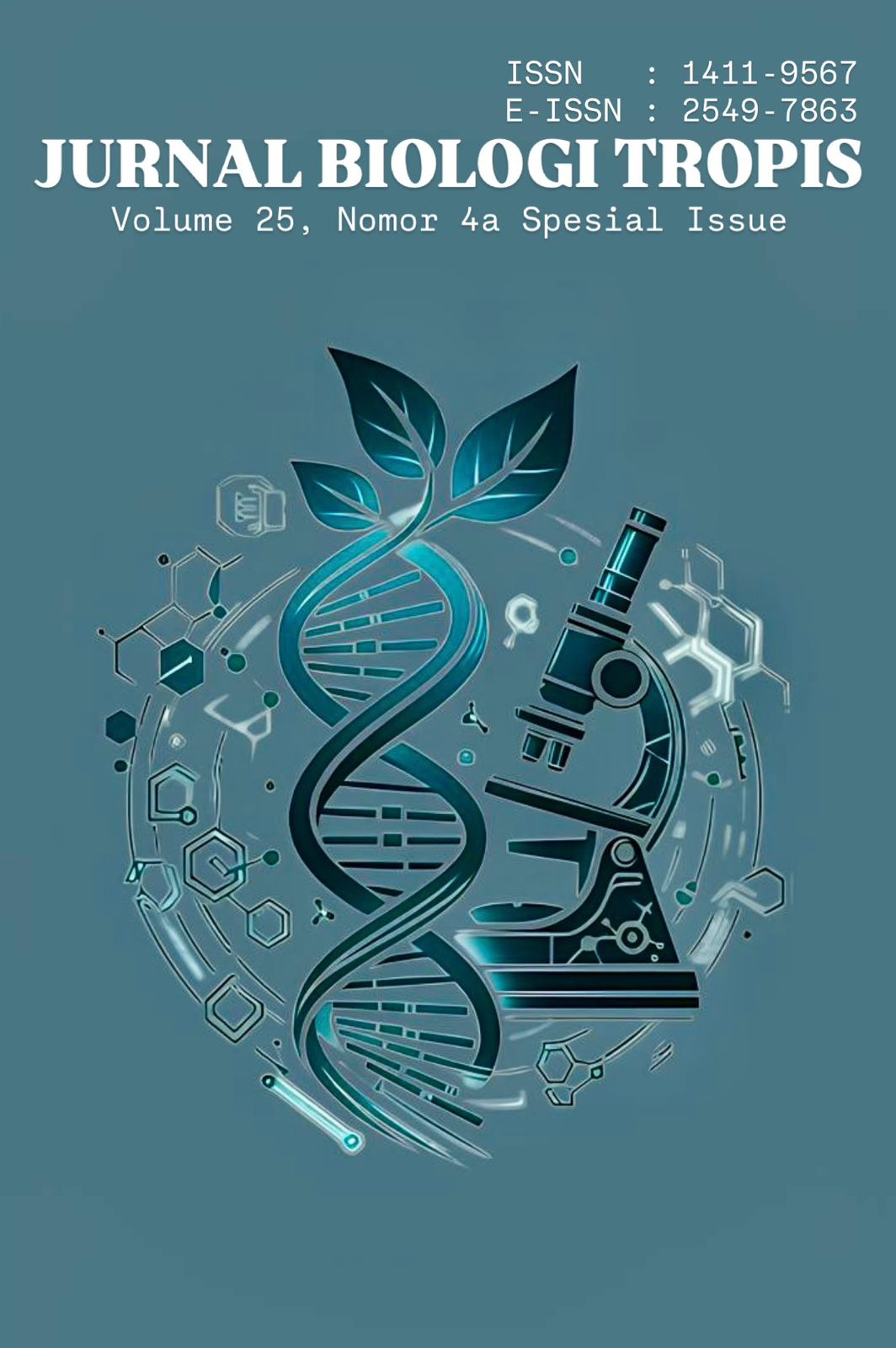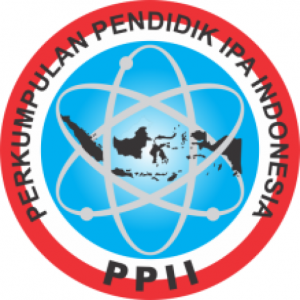Antibacterial Activity Test of Various Ethanol Solvent Concentrations Extract of Sweet Orange (Citrus sinensis) Peel on Escherichia coli, Shigella dysenteriae, and Salmonella typhii
Authors
Tabitha S. G. Purba , Joshua H. L. TobingDOI:
10.29303/jbt.v25i4a.10597Published:
2025-11-14Issue:
Vol. 25 No. 4a (2025): Special IssueKeywords:
Antibacterial activity, Citrus sinensis, Orange peel extract, Escherichia coli, Salmonella typhii, Shigella dysenteriae, Inhibition zone, Ethanol concentrationArticles
Downloads
How to Cite
Downloads
Abstract
The rise of antibiotic resistance necessitates the discovery of new antibacterial agents. Sweet orange (Citrus sinensis) peel often considered waste, contains bioactive compounds with potential antimicrobial properties. This study aimed to evaluate the antibacterial activity of ethanol extracts from sweet orange peel on Escherichia coli, Shigella dysenteriae, and Salmonella typhii. This laboratory experimental study uses sweet orange peel extracted by maceration using 30%, 40%, and 50% ethanol as solvent. The highest average inhibition zones were observed at the 50% concentration for all bacteria: E. coli (7,683 mm), S. typhii (8,400 mm), and S. dysenteriae (7,250 mm). Statistical analysis confirmed that the extract concentration has a very significant effect (p = 0,000) on the inhibition zone, with higher concentrations yielding larger zones. A significant interaction was also found between the type of bacteria and time (p = 0,000). Ethanol extract of sweet orange (Citrus sinensis) peel has moderate antibacterial activity against Escherichia coli, Shigella dysenteriae, and Salmonella typhii. Its effectiveness is concentration-dependent, with the 50% ethanol extract shows the strongest inhibition. This suggests that orange peel waste is a promising source of natural antibacterial compounds.
References
Amelia, S., Amananti, W., & Febriyanti, R. (2021). Perbandingan Metode Maserasi dan Refluks terhadap Aktivitas Antioksidan dari Ekstrak Daun Sirsak (Annona Muricata L.). Diploma, DIII Farmasi Politeknik Harapan Bersama. http://eprints.poltektegal.ac.id/125/
Andrade, M. A., Barbosa, C. H., Shah, M. A., Ahmad, N., Vilarinho, F., Khwaldia, K., Silva, A. S., & Ramos, F. (2023). Citrus By-Products: Valuable Source of Bioactive Compounds for Food Applications. Antioxidants, 12(1), Article 1. https://doi.org/10.3390/antiox12010038
Arrofiqi, M. R., Sakti, A. S., & Dita, F. (2024). Kajian Literatur: Aplikasi Sejumlah Metode Ekstraksisi Konvensional untuk Mengekstraksi Senyawa Fenolik dari Bahan Alam. Jurnal Penelitian Farmasi & Herbal, 7 (1). https://doi.org/10.36656/jpfh.v7i1.1972
Astuti, M. T., Ningsih, A. R., & Marcellia, S. (2021). Uji Aktivitas Ekstrak Etanol Kulit Jeruk Lemon (Citrus limon L.) terhadap Bakteri Salmonella thypi dan Escherichia coli. Jurnal Mandala Pharmacon Indonesia, 7(2), Article 2. https://doi.org/10.35311/jmpi.v7i2.84
Budiarto, R., Mubarok, S., Nursuhud, N., & Rahmat, B. P. N. (2023). Citrus is a Multivitamin Treasure Trove: A Review. Journal of Tropical Crop Science, 10(01), Article 01. https://doi.org/10.29244/jtcs.10.1.57-70
Cacique, A. P., Barbosa, É. S., Pinho, G. P. de, & Silvério, F. O. (2020). Maceration Extraction Conditions for Determining the Phenolic Compounds and the Antioxidant Activity of Catharanthus Roseus (L.) G. Don. Ciência e Agrotecnologia, 44, e017420. https://doi.org/10.1590/1413-7054202044017420
Do, Q. D., Angkawijaya, A. E., Tran-Nguyen, P. L., Huynh, L. H., Soetaredjo, F. E., Ismadji, S., & Ju, Y. H. (2013). Effect of Extraction Solvent on Total Phenol Content, Total Flavonoid Content, and Antioxidant Activity of Limnophila Aromatica. Journal of Food and Drug Analysis, 22(3), 296–302. https://doi.org/10.1016/j.jfda.2013.11.001
Pabundu, D., Simbala, H., & Hariyanto, Y. (2024). Antibacterial Efficay Test of Ethanol Extract of Yaki Areca Nut (Areca vestiaria) Against the Growth of Propionibacterium acnes, the Cause of Acne. PHARMACON, 13(3), 761-769.
Hakim, A. (2024). Narrative Review: Optimasi Etanol sebagai Pelarut Senyawa Flavonoid dan Fenolik. Research Gate. https://doi.org/10.33084/jsm.v6i1.1641
Ihsan, B. (2021). Identifikasi Bakteri Patogen (Vibrio spp. dan Salmonella spp.) yang Mengontaminasi Ikan Layang dan Bandeng di Pasar Tradisional: Identification of Pathogenic Bacteria Contamination (Vibrio spp. and Salmonella spp.) in Flying Fish and Milkfish in Traditional Markets. Jurnal Pengolahan Hasil Perikanan Indonesia, 24(1), 89–96. https://doi.org/10.17844/jphpi.v24i1.34198
Jap, A. L. S., & Widodo, A. D. (2021). Diare Akut yang Disebabkan oleh Infeksi. Jurnal Kedokteran Meditek, 27(3), 282–288. https://doi.org/10.36452/jkdoktmeditek.v27i3.2068
Kamel, F., Sabir, S., Mahal, A., & Wei, X. (2022). In vitro Antibacterial Activity of Orange Peel Oil Extract from Citrus Sinensis Fruit in Erbil. Egyptian Journal of Chemistry, 65(4), 157–160. https://doi.org/10.21608/ejchem.2021.93484.4416
Khastini, R. O., Zahranie, L. R., Rozma, R. A., & Saputri, Y. A. (2022). Review: Peranan Bakteri Pendegradasi Senyawa Pencemar Lingkungan melalui Proses Bioremediasi. Bioscientist:Jurnal Ilmiah Biologi, 10(1), 345–360. https://doi.org/10.33394/bioscientist.v10i1.4836
Kherid, M. T. (2020). Uji Aktivitas Antibakteri Ekstraksi Etanol Daun Kacapiring (Gardenia augusta Merr.) dan Fraksinya terhadap Salmonella typhi. Pharmaceutical Journal of Indonesia, 5(2), 97–102. https://doi.org/10.21776/ub.pji.2020.005.02.5
Kotloff, K. L., Nataro, J. P., Blackwelder, W. C., Nasrin, D., Farag, T. H., Panchalingam, S., Wu, Y., Sow, S. O., Sur, D., Breiman, R. F., Faruque, A. S., Zaidi, A. K., Saha, D., Alonso, P. L., Tamboura, B., Sanogo, D., Onwuchekwa, U., Manna, B., Ramamurthy, T., … Levine, M. M. (2013). Burden and Aetiology of Diarrhoeal Disease in Infants and Young Children in Developing Countries (the Global Enteric Multicenter Study, GEMS): A prospective, case-control study. The Lancet, 382(9888), 209–222. https://doi.org/10.1016/S0140-6736(13)60844-2
Lase, H. (2021). Hubungan Personal Hygiene Penjamah dengan Keberadaan Bakteri Eschericia coli pada Es Batu yang Digunakan Penjual Minuman di Kecamatan Medan Timur Kota Medan Sumatera Utara. https://repository.uhn.ac.id/handle/123456789/5250
Liyantifa, B., & Afryansyah, A. (2025). Peran Mikrobiota Usus dalam Homeostasis Imun: Pendekatan Kritis untuk Inovasi Kesehatan di Era Society 5.0. Jurnal Penelitian Sains, 27(0), 1–8. https://doi.org/10.56064/jps.v27i0.1183
Muttaqin, A. (2025). Hubungan Sanitasi Lingkungan dengan Kejadian Diare pada Balita di Kelurahan Angke Kecamatan Tambora Kota Administrasi Jakarta Barat Tahun 2024. Jurnal Untuk Masyarakat Sehat (JUKMAS), 9(1), 104–116. https://doi.org/10.52643/jukmas.v9i1.6114
Niken, N., Arman, E., Pebriansyah, R., & Yusuf, R. N. (2023). Uji Efekivitas Antibakteri Ekstraksi Kulit Jeruk Manis (Citrus Sinensis) terhadap Pertumbuhan Bakteri Staphylococcus aureus. Jurnal Kesehatan Saintika Meditory, 6(2), 296–305. https://doi.org/10.30633/jsm.v6i2.1961
Nomura, R., Ohata, J., Otsugu, M., Okawa, R., Naka, S., Matsumoto-Nakano, M., & Nakano, K. (2021). Inhibitory effects of flavedo, albedo, fruits, and leaves of Citrus unshiu extracts on Streptococcus mutans. Archives of Oral Biology, 124(105056). https://doi.org/10.1016/j.archoralbio.2021.105056
Oikeh, E. I., Oviasogie, F. E., & Omoregie, E. S. (2020). Quantitative Phytochemical Analysis and Antimicrobial Activities of Fresh and Dry Ethanol Extracts of Citrus sinensis (L.) Osbeck (sweet Orange) peels. Clinical Phytoscience, 6(1), 46. https://doi.org/10.1186/s40816-020-00193-w
Putri, M. F. E. (2023). Determinan Kejadian Demam Typhoid di Wilayah Kerja Puskesmas Rawat Inap Kemiling Kota Bandar Lampung Tahun 2023. Diploma, Poltekkes Kemenkes Tanjung Karang. https://doi.org/10/DAFTAR%20PUSTAKA.pdf
Stanaway, J. D., Reiner, R. C., Blacker, B. F., Goldberg, E. M., Khalil, I. A., Troeger, C. E., Andrews, J. R., Bhutta, Z. A., Crump, J. A., Im, J., Marks, F., Mintz, E., Park, S. E., Zaidi, A. K. M., Abebe, Z., Abejie, A. N., Adedeji, I. A., Ali, B. A., Amare, A. T., … Hay, S. I. (2019). The Global Burden of Typhoid and Paratyphoid Fevers: A Systematic Analysis for the Global Burden of Disease Study 2017. The Lancet Infectious Diseases, 19(4), 369–381. https://doi.org/10.1016/S1473-3099(18)30685-6
Sudiri, S. H. (2019). Profil Penggunaan Antibiotik pada Pasien Rawat Jalan di RST Wirasakti Kupang Periode Maret–Mei 2018. Diploma, Poltekkes Kemenkes Kupang. http://repository.poltekeskupang.ac.id/2076/
Susanti, N., Rasyid, Z., Hasrianto, N., Redho, A., & Fadhli, R. (2024). Analisis Penyakit Diare di Desa Cipang Kiri Hulu dan Faktor Lingkungan Fisik yang Mempengaruhinya. Jurnal Kesehatan Lingkungan Indonesia, 23(3), 374–381. https://doi.org/10.14710/jkli.23.3.374-381
Wu, G. A., Terol, J., Ibanez, V., López-García, A., Pérez-Román, E., Borredá, C., Domingo, C., Tadeo, F. R., Carbonell-Caballero, J., Alonso, R., Curk, F., Du, D., Ollitrault, P., Roose, M. L., Dopazo, J., Gmitter, F. G., Rokhsar, D. S., & Talon, M. (2018). Genomics of the Origin and Evolution of Citrus. Nature, 554(7692), 311–316. https://doi.org/10.1038/nature25447
License
Copyright (c) 2025 Tabitha S. G. Purba, Joshua H. L. Tobing

This work is licensed under a Creative Commons Attribution 4.0 International License.

Jurnal Biologi Tropis is licensed under a Creative Commons Attribution 4.0 International License.
The copyright of the received article shall be assigned to the author as the owner of the paper. The intended copyright includes the right to publish the article in various forms (including reprints). The journal maintains the publishing rights to the published articles.
Authors are permitted to disseminate published articles by sharing the link/DOI of the article at the journal. Authors are allowed to use their articles for any legal purposes deemed necessary without written permission from the journal with an acknowledgment of initial publication to this journal.


























